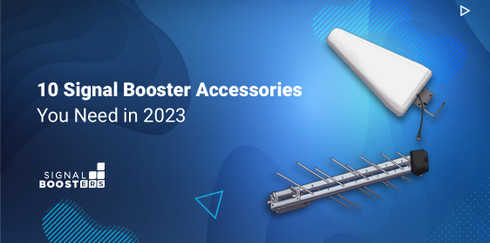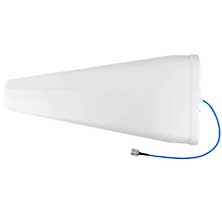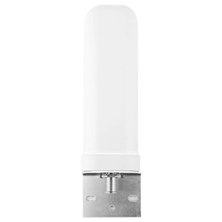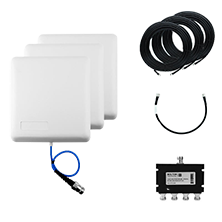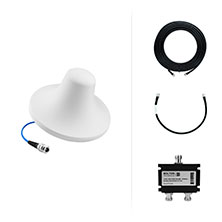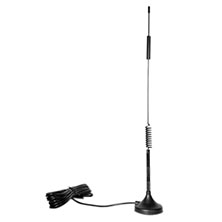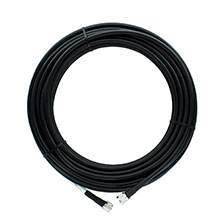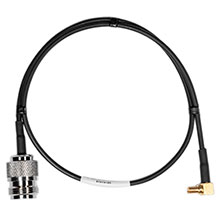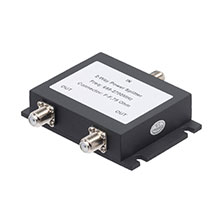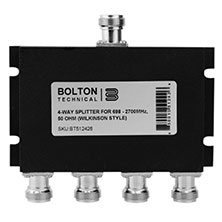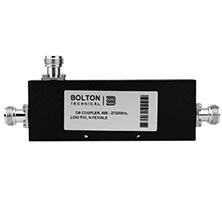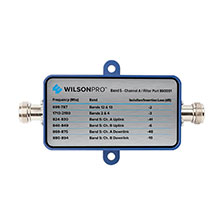The 10 Best Signal Booster Accessories You Need
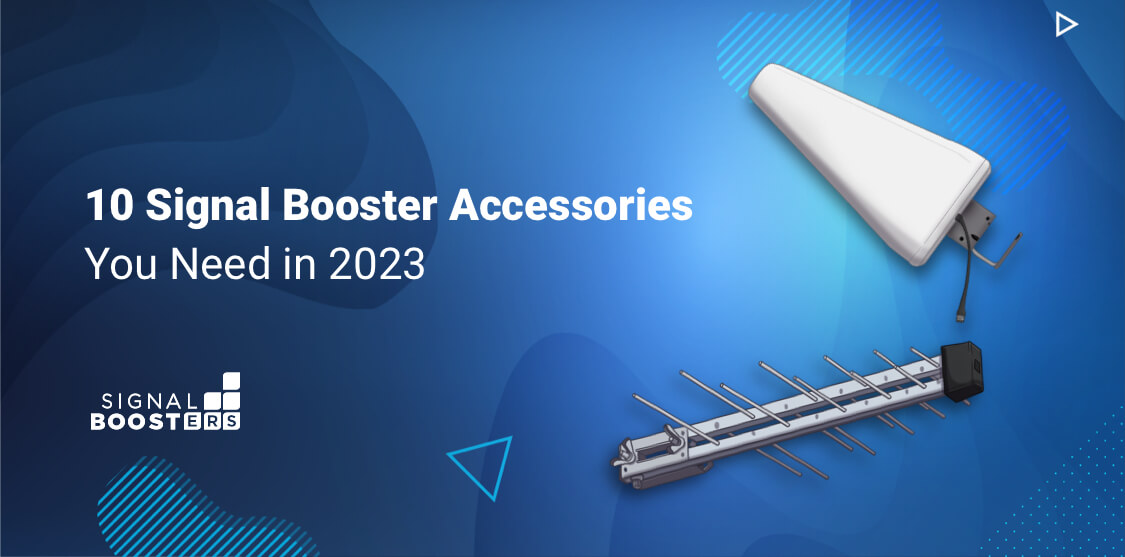
For many, cell phone signal boosters aren't a luxury. They’re a necessity. Our lives depend on staying connected for work, play, and everything in between. For that we need cell signal. Unfortunately, cell signal isn't always strong, or available.
Take advantage of our system design and installation services. Learn more or call us for a free consultation: 1-800-969-8189.
Signal booster accessories are the difference between great performance and average. There are all sorts of accessories: antennas, surge protectors, and types of cable. Knowing what you need for your booster may be confusing, so let us help you out!
1. Cellular Antennas
It's fair to say antennas are the most important accessory for any signal booster. Without them, you wouldn't be able to get any signal to boost. If you live in a rural area with weak outside signal, it's even more vital to have a decent antenna.
Antennas come in all forms, for all sorts of situations. Some broadcast signal, and some receive it. Some are for indoors, and some can be deployed anywhere. You get vehicle antennas, dome antennas, great big Yagi antennas, parabolic antennas, the list is almost endless. Knowing which antenna you need for your situation is vital to help your signal booster work at its best.
Yagis, Omnis and LPDAs
Both Yagis and Omnis draw in outside signal and send it via a cable to a receiving device, the main difference is how these two get the signal.
Yagis
Yagi antennas are directional. They typically have a 45-90 degree directional field for picking up signal. This makes them more powerful, and have higher gain than other antenna designs. Higher gain is essential if you live in a rural area or any area where the outside signal is weak.
Their narrow beam does mean that they tend to boost only one carrier unless there is more than one carrier within their field. So they are very powerful but limited in their reach. They also are not good for any moving vehicle like boats or trucks, as the signal direction is always moving. To make the most of their power you need to set them up on a high, stable area and point them directly at the signal source.
The Quicksilver | Bolton Technical Yagi Directional Cellular Antenna
Yagi directional antenna for building boosters
- Yagi directional outdoor antenna
- For 50 Ohm Signal Boosters
- High efficiency and compact design
- Up to +11 dB gain
The Bolton Technical Yagi Directional antenna is a wideband outdoor antenna that captures existing cellular signal across the 698-4000 MHz frequencies.
This antenna is designed as an accessory for or an addition to a 50-Ohm cellular signal booster system and boosts gain by up to 11 dBi.
Omnis
Omni antennas on the other hand are the jack-of-all-trades option. These guys draw in all signal from all directions. Because of this, they aren't nearly as strong as a Yagi. They are great if your outside signal isn't too bad, and you want a multi-carrier setup. They are also much easier to install than a Yagi because they don't have to point in any specific direction. Their gain isn't as good as other antenna types, and they can be overwhelmed by “signal noise”. This is a kind of background frequency that the antennas have to filter out. If you live in an area where the outside signal is pretty good, but you need to boost your inside signal, these are a good choice.
The All 'Rounder | Bolton Technical Omni-Directional Cellular Antenna
- Omnidirectional outdoor antenna
- Designed for rooftop mounting to capture outdoor cellular signal
- For 50-Ohm Signal Boosters
- High efficiency and compact design
- Up to +4 dBi gain.
The Bolton Technical omnidirectional antenna is a wideband outdoor antenna that captures existing cellular signal across the 698-2700 MHz frequencies.
It is the perfect signal booster accessory for any 50-Ohm cellular signal booster system. This omnidirectional outdoor antenna boosts gain at the point of capture by up to 4 dBi.
Log-Periodic Directional Antennas (LPDAs)
LPDA antennas are even more specific than regular Yagis. They look similar to a Yagi but only work between the 698-2700 MHz frequencies. The main benefit of an LPDA antenna is its longer range and higher gain. They can offer up to 13.5 dBi, compared to 5 dBi and 9.5 dBi on Omnis and Yagis respectively
The Arrow LPDA – High Gain Directional Antenna
- Over 5 miles of range
- Superior gain: up to +12 dBi
- N-Female connector ports, 50-Ohm
- Works across the 698-2700 MHz cellular bands
- Weatherproof, all-weather tested
If you are looking to greatly boost signal in any situation, the Arrow is your choice. These antennas have more gain and are more powerful than a regular Yagi. Wide bandwidth support means that you can make use of more frequencies. Stay connected even if your nearest tower is miles away, making the Arrow the perfect choice for rural areas.
Panels & Domes
Indoor antennas usually come in one of two forms: Panel or Dome. These both look as they are described. Panel antennas are flat boards that sit flush against a wall and dome antennas are usually found on a ceiling.
Panel Antennas
Panel antennas broadcast signal in a cone shape ranging from 45 to 70 degrees. This makes them perfect for corridors or narrow rooms. This signal shape means that the closer you are to the antenna, the better the signal is. Imagine a beam of light from a torch. Closer to the bulb the light is bright, but the further away at the cone end, the light is faded. A great benefit to this, however, is that you can focus your panel antenna. That's great for living rooms, conference rooms, and other spaces that are a higher priority. You can even install them on a ceiling to send a cone of signal through your home, penetrating floors.
Bolton Technical Single Panel Antenna Expansion Kit
- Highest quality panel antenna and cabling
- Tremendous savings while bundled
- Expand your coverage with an extra antenna
- For use with any 50-Ohm cellular signal booster system
Expanding the coverage of your signal booster system has never been simpler or more affordable than with the Bolton Technical Single Panel Antenna Expansion Pack. The kit contains everything you need to expand your signal boosters' power throughout your space. The Bolton Technical Single Panel Antenna Expansion Pack can be used on nearly any 50-Ohm system to expand its coverage to other floors and around difficult building materials.
Dome Antennas
Dome antennas broadcast signal 360 degrees in half a sphere. Imagine half a bubble stuck to your ceiling. you can bet up to about 50 feet of signal coverage with a dome antenna, but that depends on how strong your outside signal is. You can install them in crawl spaces and attics, and they send their signal through thin floors. This does make them better for single-story homes or business spaces where you don't mind seeing them. They are the perfect indoor signal booster accessory to cover every inch of your space in great signal. They also come standard with many of our pre-built kits.
Bolton Technical Single Dome Antenna Expansion Kit
- High-quality dome antenna and cabling
- Save up to 25% when you bundle
- Expand your signal coverage area with an extra antenna
- For use with 50-Ohm cellular signal booster systems
Expanding the coverage of your signal booster system has never been simpler or more affordable than with the Bolton Technical Dome Panel Antenna Expansion Pack. The kit comes with everything you need to expand the signal from your booster. The Bolton Technical Single Dome Antenna Expansion Pack can be used on nearly any 50-Ohm system to expand its coverage to other floors and around difficult building materials.
Outside Vehicle and IoT Antenna Signal Booster Accessories
Cellular antennas are used everywhere, for many different reasons. Vehicle antennas and IoT antennas both need to be weatherproof, and both need to draw outside signal in potentially bad signal areas. In application they are both similar, although they do look different. Most IoT application antennas only need basic connectivity, while vehicle antennas can be quite complex.
Vehicle Antennas
One of the most common applications is vehicle antennas. If you have bought a vehicle signal booster, like the weBoost Drive, you need a good antenna to draw in the signal to the booster. Because a vehicle is always on the move, it may not always be in an area of good signal so you need every bit of height and technology to keep you connected. In many ways, they are the same as building antennas, except that every vehicle antenna is omnidirectional. Antenna size and power will depend on your needs, so trucks will have bigger profiles than RV antennas.
You also get MIMO antennas that combine several connections both at the source and the destination, i.e. the booster. This allows for faster connection speeds and more devices to be connected at the same time.
Bolton Technical Blade – 5G Cellular Truck Antenna
Bolton Blade Overview:
- High-gain omnidirectional
- Wideband
- Weatherproof
- Commercial-grade, whistle-free design
- 3/8 x 24 threaded base with quick disconnect coax cable
The Bolton Technical Blade is a high-performing, commercial-grade, 5G-capable cellular truck antenna. At just over two feet tall, it’s discreet but very functional for all signal environments. Extremely customizable, it's perfect for any sized truck – from pickups to 18-wheelers and everything in between.
IoT Antennas
IoT devices have a different set of needs than many other signal boosters or routers. They need usually a single carrier and are often out in harsh environments. They need to be weatherproof, temperature proof, and able to get a signal to your booster no matter what happens. Often you can use a simpler vehicle antenna for an IoT application, depending on how it needs to be mounted. Our choice for most IoT scenarios is the Bolton Tallboy
The Tallboy | Bolton Technical 12-inch Magnet Mount Cellular Antenna
- Omnidirectional cellular antenna for outdoors environments
- Perfect for IoT and vehicles
- Up to +6.1dBi gain, twice as powerful as the 4-inch antenna
The Bolton Technical 12” Magnet Mount antenna is a wideband outdoor antenna that captures existing cellular signal across the 698-4000 MHz frequencies.
This antenna is a perfect choice for outdoor applications, especially where signal is weak.
Other Antennas for Cell Signal Boosters
We have only just begun to scratch the surface of the multitude of antenna types. There is an antenna for every situation, be it on the move or stationary. Have a look at this article for a more in-depth explanation of all sorts of antennas.
2. Surge Protectors
Lightning surge protectors are a vital and sometimes overlooked piece of equipment. If you don't want your signal booster to be zapped by a bolt of super-powered energy, you need to make sure you have one of these. Surge protectors won't protect your booster from a direct lightning strike, as those are incredibly powerful. It will however protect it from transients, which are short voltage spikes that can reach thousands of volts, if properly grounded.
Surge protectors come in two forms. Both of them work in the same way and ground excess energy before it runs down your cables and reaches your signal booster. The first form is 50-Ohm surge protectors that use N-Female connectors. They're most often used for enterprise or pro-grade systems. 75-Ohm Lightning Surge Protectors use F-Female connectors. They're most often found with residential units or when using RG6 or RG11 cables.
To find out how to install your surge protector, have a look at this article.
Bolton Technical Lightning Surge Protector | 75-Ohm
- High-quality, durable build
- Works with all 75-Ohm systems
- 50-Ohm version also available.
- F-Female connectors
Protect your 75-Ohm accessories and devices from lightning strikes and power surges with the Bolton Technical Lightning Surge Protector. 50-Ohm version also available.
3. Cables for Cell Signal Boosters
Never underestimate the importance of booster cabling. They are like the veins in a great beast, carrying signal from the antenna to the booster and through to the inside antennas. Without them, there would be no signal boosting. If you use the wrong cables you can lose a lot of signal, which will impact the effectiveness of the whole system. Usually, you can get away with the cables that come with your kit, but if have a unique or bigger floor plan you can always add some extra cables.
Coaxial Cables
Coaxial cables are high frequencies lines that deliver electrical signal with the least loss. Imagine a highway where traffic flows fast and cars aren’t pushed off the road. Coax cables come in all sorts of sizes and use. To find the best cable for your system, have a look at the installation guide and manual.
Bolton Technical N-Male to N-Male Bolton400 Ultra Low-Loss Coax Cable | 50 ft. Cable
- LMR® 400 equivalent
- Ultra Low-Loss Cable
- N-Male to N-Male connectors
Bolton400 (LMR® 400-equivalent) is a 50ft. Ultra-low-loss coax cable for commercial & industrial installations, and it comes in pre-cut terminations and
Other Cables for Cell Signal Boosters
There are lots of different sorts of cables besides Coax. For instance, If you want to connect your residential router to an outside antenna, your need to get a jumper cable. It is less complex than a coax cable but still helps to improve your booster performance.
Bolton Technical 18 inch TS-9 to N-Female Jumper Cable
- TS-9 to N-Female connectors
- Low-Loss Cable
- For connecting cellular routers to outdoor antennas for capturing cell signal
The Bolton Technical 18-inch TS-9 to N-Female jumper is a high-quality cable designed to connect a cellular router to an outside antenna designed to capture cellular signal. This is perfect for anyone looking to attach an outdoor antenna or signal booster with an N-Male termination to their TS-9 capable router.
To learn more about cabling and which ones do what, have a look at this article on Understanding Coaxial Cables.
4. Splitter Cell Signal Booster Accessories
If you need to use more than one indoor antenna for any reason, you need to install a splitter. Signal can be bad indoors for various reasons, have a look at this article. To beat this, you can install a whole lot of indoor antennae to cover every inch of your space.
The problem now is that most signal boosters only have one antenna port, so you need something to link all other antennas to your booster. Enter the splitter. A splitter allows signal from the booster to be sent out in various directions. You can choose either 2 or 4 outputs, and with extra cabling, you can make sure that every area of your home or office has good signal.
Splitting the signal does result in a small amount of signal loss, so you need to use the correct splitters to negate this. The other thing to consider is which Ohm splitter to buy. Have a look at your booster’s manual. If it is a 50-Ohm and uses 50-Ohm cabling then you need a 50-Ohm splitter. The same goes for a 75-Ohm booster. You can find out more about taps and splitters here.
Bolton Technical 2-Way Splitter For 698-2700Mhz, 75-Ohm
- For 75-Ohm signal boosters and accessories
- High-quality build
Bolton Technical (75-Ohm) 2-Way Splitter For 698-2700Mhz, Low-PIM splitter is an extremely low loss, high-quality splitter designed for multiple indoor antennae runs. It splits the outgoing signal into two equal strength lines for continued cable runs, with a loss of up to 3 dB for each. A 50-Ohm version is also available, so buy the appropriate one for your system.
Bolton Technical Low-PIM 4-Way Splitter 698-2700Mhz 50-Ohm
- For 50-Ohm signal boosters and accessories
- High-quality build
- Splits the amplified signal with minimal loss (-6 dB)
The Bolton Technical 4-way, Low-PIM splitter is an extremely low loss, high-quality splitter designed for multiple indoor antenna runs. It splits the outgoing signal into four equal strength lines for continued cable runs, with a loss of up to 6 dB for each. This splitter is for use on booster systems that run 50-Ohm cabling.
5. Coupler/Tap Signal Booster Accessories
If you need to install more antennas than your system comes with for your home or office, couplers are another way to go. They are good for uneven cable runs and situations where you need to split the signal unevenly. Unlike splitters, these guys can send more signal through one port, which is good for longer cable runs. For example, Imagine that you have to install two extra antennas. One is close to the booster, and one is far away. You get the best performance from the antenna that is far away you need to send a stronger signal to it that the closer antenna. This is because signal gets lost along long cable runs. That’s what a coupler or splitter does.
Bolton Technical 10 dB Coupler, 698-2700 MHz, Low-PIM, N-Female
- Low Passive Intermodulation (-153dBc)
- Low VSWR & Insertion Loss
- High Isolation, Outdoor IP65
The Bolton Technical 10 dB Low-PIM coupler (also known as a tap) is an extremely low-loss, high-quality coupler designed for multiple indoor antennae runs. If you have multiple antennas to drop in a line, this coupler will get that done.
Need help with cell phone signal booster accessories? Give us a call at 1-800-470-6777.
Take advantage of our system design and installation services. Learn more or call us for a free consultation: 1-800-969-8189.
6. Diplexer/Combiner Signal Booster Accessories
If you’re trying to maximize the amount of signal that gets to your booster, you are likely using a Yagi or another directional antenna. These are great but very specific. Since they only point in one direction to the nearest tower, they mostly only pick up one carrier or very specific frequencies, So if you need to use more than one carrier or a wider frequency band, you need more than one Yagi. To combine the signals from your outside antennas down into your single signal booster, you use a Diplex or Combiner.
If you have one antenna that picks up low band frequencies (600 - 960 MHz), and another that works on the high band frequencies (1630 - 2300 MHz). You will need a Combiner to blend them for your signal booster. If you aren't sure what frequencies you are receiving, websites like Cell Mapper can help you figure this out.
SureCall Wide Band Diplexer
- Wide Band Diplexer
- High Quality, Low-loss connector
- For 50 ohm signal boosters and accessories
The Surecall Wide Band Diplexer splits cellular frequencies for 50-Ohm signal boosters and accessories.
7. Attenuators /Filters for Cell Signal Boosters
Attenuators
Sometimes when you have more than one booster or antenna you end up with a lot of noise. Too much noise is essentially too many signals bombarding the booster at the same time. Imagine that you are in a crowded room and you need to listen to one or two voices but everyone is shouting. The FCC determines that when this happens your booster needs to shut off or throttle certain bands to avoid interference with nearby cell towers.
Your booster should be able to tell you whether it is getting overloaded. If you aren't sure, check the manual to learn which lights on the device mean what. Some boosters like the Uniden have LCD screens that give you a full rundown of your booster's status.
The simplest way of fixing an overloaded system is to turn your antenna away or to move it to a spot with weaker signal. If this can't be done, however, then you need to use an Attenuator or a filter. Attenuation is the loss of signal, so an attenuator reduces the signal strength over a length of coax cable. It is installed along the cable between your antenna and booster and can reduce signal by up to 20 dB. This may sound counter-intuitive, after all, isn't our main mission to get as much gain as possible? Yes, but in an urban area where there are loads of towers, you experience signal loss as your booster tries to work out which signal to use. An attenuator just quiets the room a bit, allowing your system to hear the correct voices.
SureCall 5W RF Attenuator 5dB/10dB/20dB
- Commercial grade
- Meet international standards
- N-Male to N-Female
SureCall's Attenuators work well in situations where you need to reduce the signal levels coming from or going to cell towers.
Filters
Filters on the other hand only reduce certain frequencies, unlike attenuators that reduce all frequencies. They quiet the voices in a room and make the correct ones louder. If you are experiencing overload on only certain frequencies, then a filter is for you. It's simple to install and can make a massive difference in your signal booster’s performance. If you aren't sure which one you need, give us a shout on 1-800-568-2723.
WilsonPro Band 5 Channel A Filter (F Connector)
- Filters out the undesired signal on Band 5
- Connects the outside antenna and the amplifiers
- Easy to install
WilsonPro Band 5 Channel A Filter with F-Connector. Reduce noise on certain frequencies, boosting bars on the ones you need.
8. Power Supply Accessories for Signal Boosters
It could be argued that power supplies are the single most important signal booster accessory you can have. After all, what a piece of tech without power running to it? Most signal boosters come with a power supply, especially if you buy one of our kits. That being said power supplies can break or go missing, so having a spare on hand is useful.
The power supply you need will depend on what your booster needs to run. You get different voltages and different connections such as vehicle of AC/DC. If you aren't sure what power supply you need, have a look at your boosters manual, or give us a call at 1-800-470-6777.
weBoost (Wilson) 859923 6V DC Vehicle Hardwire Power Supply
- Works with 470108, 470102, and other 6V Amplifiers
- Connects to your vehicle's power system
- High-quality build
The Wilson DC 6V Hardwire Power Supply Assembly is designed for the Dual Band Wireless Mobile signal boosters/amplifiers. Keep your signal booster powered up with a direct connection to your vehicle power supply.
9. Mount Accessories for Cell Signal Boosters
Mounting your antenna to either your vehicle or building is almost as important as the antenna itself. Without a solid mount, your antenna will likely fall and stop working. There are various ways that you can mount antennas to all sorts of places. Brackets, pole mounts, and magnets mounts are just a fraction of the ways you can attach your antenna to anything. Give us a shout if you are unsure which mount will work best for you.
Bolton Technical Tri-Mag Antenna Mount
- Massive hold power with three 4" ceramic 8-pole magnets
- Magnets enclosed in durable ABS plastic
- Rubber pads under each magnet keep body surface safe
- 1/4" thick rust-free polished aluminum mounting plate
- 3/8" x 24 threaded antenna mount
The Bolton Technical Tri-Magnet Antenna Mount can attach almost any antenna to your vehicle. With three rugged magnets, you can stick antennas to most parts of your car or truck using the coax.
Bolton Technical 10-inch J-Pole Mount Accessory Kit
- Simplify your next outdoor antenna installation.
- Antenna Pole Mounting Assembly (wall-mount, U-bracket)
- Designed for mounting outdoor antennas on the roof or wall of a building
The Bolton Technical 10-inch pole mount is designed for most outdoor antennas. If you don't have a chimney or a flat surface to mount your antenna onto, this is the right signal booster accessory. Mount the j-Pole onto a flat surface like a wall using the included hardware. Simple to install, the J-Pole allows you to put your antenna where you need it.
10. Cellular Router Signal Booster Accessories
Finally, we come to routers. Although not the first thing you think about when you consider a signal booster accessory if you want a WiFi connection in your home a router is essential. Signal boosters and routers go hand in hand for a fast connection, especially if you live in a rural area. Routers can be installed in your vehicle or your home, giving you access to WIFI from cell signal.
Inhand Networks InRouter302 Compact Industrial LTE CAT4 Router
- Certified for Use with AT&T, Verizon, & T-Mobile
- Speeds Up to 150 Mbps
- Dual-Sim Card Capabilities
- Remote Device Management
- Easy to Install, 3-year Warranty
- Pairs perfectly with the weBoost Signal 4G M2M
The IR302 CAT4 from InHand is a great LTE router that provides a steady internet connection for your home, office, or RV. It has two LAN ports as well as two SIM slots. Get up to 150 Mbps download and 50 Mbps upload speeds, perfect for those who need a good internet connection at home or on the move. Simple plug-and-play installation makes it a breeze to set up.
Signal booster accessories could be the difference between mediocre and great performance from your device. Outside signal, correct placing, directing the signal to the right places and the right power supply are all essential. If you need any help or advice on which accessories are best for you, don't hesitate to contact us at 1-800-470-6777
Need Help Finding the Best Antenna for Your Needs? Contact Us
Signal Boosters is a leading provider of cell phone signal boosters for homes, vehicles, and commercial buildings. We specialize in consumer-friendly kits as well as customized RF systems for cellular, public safety two-way radio, DAS, and WiFi.
We’re here to assist with any issues you might be experiencing with poor cell service. Contact us today, or call us at 1-800-470-6777.
Interested in Learning More? Check Out Our Cellular Info Hub / WiFi Info Hub

